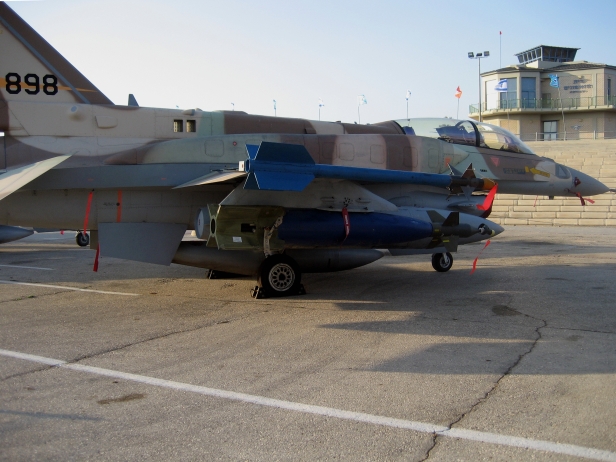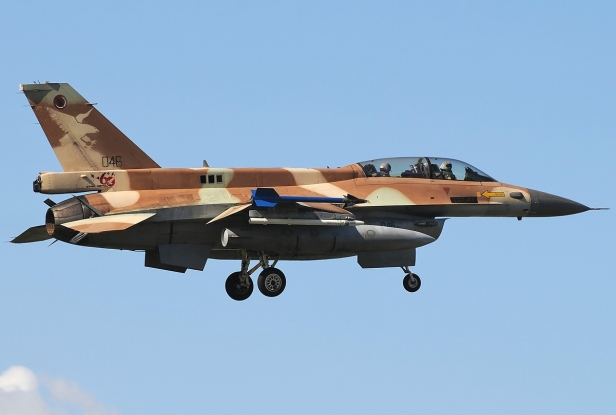News broke this morning that during the night an Israeli two-seat F-16 had come down in Israel (pictures). This chain of events started with an UAV entering Israeli airspace, which was then intercepted and shot down by an Israeli AH-64 Apache (‘Peten’/‘Saraph’ being the local designations for the AH-64A and D respectively). Four Israeli two-seat F-16’s then launched a retaliatory strike against targets in Syria, said to be the “Iranian control system” responsible for launching the UAV. Most reports seem to agree that this was located at the Syrian T4 airbase, which has played a prominent role in the Syrian war.
So far the official Israeli reports seems to avoid the use of the phrase “shot down”, instead opting for a more general “crashed”. However, while not impossible, it does seem unlikely that the F-16 would have crashed due to other reasons.
The official Israeli statements also include references to Iran being responsible. 20 minutes after the tweet above, IDF spokesperson Lt.Col. Conricus stated that “accurate hits of Iranian UAV control facility confirmed.”
The site of the Israeli crash site is located in the northwestern parts of the country (not close to Golan as some early reports indicated), at the eastern entrance to Kibbutz Harduf. The kibbutz is approximately midway between Haifa and Nazareth, and just 10 kilometers north of the major Israeli air base of Ramat David. One of the squadrons at the base is the 109th “The Valley Squadron”, which flies two-seat F-16D ‘Barak‘. While the crashed aircraft certainly could be from the squadron, it should be remembered that Israel is tiny, and the plane could easily be from another base as well.
Update 11:00 GMT +2: The aircraft is in fact a F-16I ‘Sufa‘, the highly modified Israeli version of the F-16D Block 50/52. This is clear following the publication of AFP pictures by NRK.no. The F-16I is the IDF/AF’s aircraft of choice for long-distance strikes against ground targets, and the air force operates around 100 fighters of the version (out of an original order for 102). For the past ten years it has been a mainstay of Israeli strikes in Gaza and abroad, and is likely to be the most advanced version of the F-16 in operation anywhere when it comes to the air-to-ground role. That it was chosen for the raid against T4 does not come as a surprise.

Syria has earlier been happy to throw up anything they got against Israeli strikes over their territory (including the obsolete S-200), but so far the only tangible results have been the downing of some guided munitions/missiles. Crucially, it seems that the Russian air defence systems have not taken part in the defence of Syrian territory, and that Israel and Russia in fact have a rather working de-escalatory system in place. While intervention by Russian systems can’t be ruled out, a more likely explanation is that throwing up “massive amounts” of anti-aircraft fire and possibly some older SAM’s eventually got lucky.
Edit 12:06 GMT+2: Haaretz journalist quoting anonymous Israeli sources stating that it was a Syrian surface-to-air missile that brought down the F-16I.

In retaliation to the downing of the Israeli aircraft Israel struck 12 targets inside Syria, describing them as including both Syrian air defence installations and Iranian military targets. The nature of the strikes are not described in detail, and could potentially include both ground-based systems (artillery and surface-to-surface missiles) as well as air strikes. While this certainly could escalate, it is unlikely that Syria and/or Iran are interested in a full-blown war with Israel at the current time, considering that the Syrian Civil War is still going on at a quite intense pace. However, as has been seen before, wars can happen despite no one really being interested in them. On the positive side, the fact that both pilots are safe inside Israel probably triggered a significantly more limited retaliation than what would have been the case if they had come down inside Syria and been captured there.
Edit 21:36 GMT+2: So far a number of pictures claimed to show missile debris have appeared, including the ones above. These show a missile fired by some version of the 2K12 Kub (SA-6), a system which scored major successes in the Yom Kippur War 1973, but which was decisively defeated by the Israelis nine years later in operations over Lebanon 1982.
The pictures above, though said to show a S-200, are most likely from S-125 (SA-3 Goa), an even older system which was introduced in the early 1960’s. If either of these two systems were involved in the downing there was probably a significant amount of luck involved. One possibility is that the Israeli aircraft simply ran out of energy trying to dodge a large number of missiles, some sources have stated that more than 20 missiles were fired against the strike package.
Interestingly enough, Israeli sources stated that the air defence sites targeted were S-200 and Buk-sites, though so far no pictures of Buk-missiles have so far surfaced (at least not to my knowledge).
IDF has released video said to show the downing of the Iranian UAV as well as the destruction of the command vehicle. In addition, pictures of parts of the wreckage have also been released. The wreck matches the UAV shown in the released video, and is serialled either ‘006’ or ‘900’.
While the downing of an Israeli aircraft in itself won’t change the balance of the air war, this was shown clearly by the massive wave of strikes against a variety of target following the downing, it is still a significant propaganda victory for Syria/Iran/Hezbollah. As such, the greatest danger is that it could potentially cause one or several of the actors to try and push their luck further, causing a downward spiral no one really want at the moment.


Reblogged this on vara bungas.